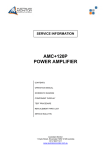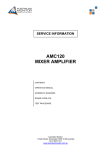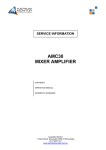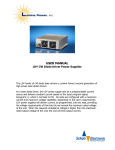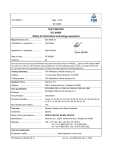Download Australion monitor AMC30 Specifications
Transcript
SERVICE INFORMATION AMC+250 MIXER AMPLIFIER CONTENTS: OPERATION MANUAL SCHEMATIC DIAGRAMS COMPONENT OVERLAYS TEST PROCEDURE REPLACEMENT PARTS LIST SERVICE BULLETINS Australian Monitor 1 Clyde Street, Silverwater NSW 2128 Australia +61 2 9647 1411 www.australianmonitor.com.au AMC SERIES + 30W/60W/120W/250W MIXER AMPLIFIERS INSTALLATION AND OPERATION MANUAL IMPORTANT SAFETY INFORMATION 1. Save the carton and packing material even if the equipment has arrived in good condition. Should you ever need to ship the unit, use only the original factory packing. 2. Read all documentation before operating your equipment. Retain all documentation for future reference. 3. Follow all instructions printed on unit chassis for proper operation. 4. Do not spill water or other liquids into or on the unit, or operate the unit while standing in liquid. 5. Make sure power outlets conform to the power requirements listed on the back of the unit. 6. Do not use the unit if the electrical power cord is frayed or broken. The power supply cords should be routed so that they are not likely to be walked on or pinched by items placed upon or against them, paying particular attention to cords and plugs, convenience receptacles, and the point where they exit from the appliance. 7. Always operate the unit with the AC ground wire connected to the electrical system ground. Precautions should be taken so that the means of grounding of a piece of equipment is not defeated. 8. Mains voltage must be correct and the same as that printed on the rear of the unit. Damage caused by connection to improper AC voltage is not covered by any warranty. 13. Do not block fan intake or exhaust ports. Do not operate equipment on a surface or in an environment which may impede the normal flow of air around the unit, such as a bed, rug, weathersheet, carpet, or completely enclosed rack. If the unit is used in an extremely dusty or smoky environment, the unit should be periodically “blown free” of foreign matter. 14. Do not remove the cover. Removing the cover will expose you to potentially dangerous voltages. There are no user serviceable parts inside. 15. Do not drive the inputs with a signal level greater than that required to drive equipment to full output. 16. Do not connect the inputs / outputs of amplifiers or consoles to any other voltage source, such as a battery, mains source, or power supply, regardless of whether the amplifier or console is turned on or off. 17. Do not run the output of any amplifier channel back into another channel’s input. Do not parallel- or series-connect an amplifier output with any other amplifier output. Australian Monitor Inc is not responsible for damage to loudspeakers for any reason. 18. Do not ground any red (“hot”) terminal. Never connect a “hot” (red) output to ground or to another “hot” (red) output! 19. Non-use periods. The power cord of equipment should be unplugged from the outlet when left unused for a long period of time. 9. Have gain controls on amplifiers turned down during power-up to prevent speaker damage if there are high signal levels at the inputs. 20. Service Information Equipment should be serviced by qualified service personnel when: 10 Power down and disconnect units from mains voltage before making connections. A. The power supply cord or the plug has been damaged. B. Objects have fallen, or liquid has been spilled into the equipment C. The equipment has been exposed to rain 11. Never hold a power switch in the “ON” position if it won’t stay there itself! 12. Do not use the unit near stoves, heat registers, radiators, or other heat producing devices. D. The equipment does not appear to operate normally, or exhibits a marked change in performance E. The equipment has been dropped, or the enclosure damaged. THIS SAFETY INFORMATION IS OF A GENERAL NATURE AND MAY BE SUPERSEDED BY INSTRUCTIONS CONTAINED WITHIN THIS MANUAL INTRODUCTION AND CONTENTS INTRODUCTION 3 FRONT PANEL 4 REAR PANEL 5 INSTALLATION 6 Master volume and overall treble and bass controls are provided, along with Vox triggered muting (defeatable), giving channel 1 priority over inputs 2, 3 and 4. There is also the facility to add a tone generator card. TROUBLESHOOTING AND BLOCK DIAGRAM 7 FUNCTIONAL NOTES AND INTERNAL ADJUSTMENTS 8 The Australian Monitor AMC+ series gives the contractor a low cost alternative in applications that are price sensitive, but still require a high quality of sound reproduction and reliability. DIMENSIONS 9 The Australian Monitor AMC+ series of amplifiers takes the heritage and reliability of our famous AMIS series amplifiers and integrates these features into low cost amplifiers for applications where reliability is everything, but the more elaborate features of our AMIS series are not required. Available in 30, 60, 120 and 250 watt versions, the AMC+ series are 2 RU mixer amplifiers, featuring 70/100 volt line and 4 ohm outputs, and 4 universal mic/line inputs. SPECIFICATIONS 10 – 11 AUS, EUR, USA Copyright 1st Apr 2005 Rev A: 1st Apr 2005 Rev B: 6th Jun 2006 Rev C: 26th May 2008 CAUTION This symbol is intended to alert the user to the presence of uninsulated “dangerous voltage” within the products enclosure that may be of sufficient magnitude to constitute a risk of electric shock to persons. RISK OF ELECTRIC SHOCK DO NOT OPEN CAUTION: TO REDUCE THE RISK OF ELECTRIC SHOCK, DO NOT REMOVE COVER (OR BACK), NO USER SERVICEABLE PARTS INSIDE, REFER SERVICING TO QUALIFIED SERVICE PERSONAL. This symbol is intended to alert the user to the presence of important operational and maintenance (servicing) instructions in the literature accompanying the appliance. Caution: WARNING! To prevent electric shock do not use this (polarised) plug with an extension cord, receptacle or other outlet unless the blades can be fully inserted to prevent blade exposure. To prevent electric shock, match wide blade of plug to wide slot, fully insert. TO REDUCE THE RISK OF FIRE OR ELECTRIC SHOCK DO NOT EXPOSE THIS EQUIPMENT TO RAIN OR MOISTURE. AMC+ SERIES INSTALLATION AND OPERATION MANUAL PAGE 3 front PANEL 1 2 3 4 5 6 1 CH 1–4 These control the levels for each channel input. 2 Bass There is 12dB of cut and boost at 100Hz. 3 Treble There is 9dB of cut and boost at 10kHz. 4 Master This controls the overall mixed output level. 5 On This LED indicates the unit is powered “on”. 6 Power This switch switches power on or off the mains. The up position is on. PAGE 4 AMC+ SERIES INSTALLATION AND OPERATION MANUAL REAR PANEL 5 4 7 6 1 CH 1–4 Each channel input section has two inputs: XLR input – This is a balanced microphone input. It has an input sensitivity of 1mV. RCA input – This is an unbalanced line level input. It has an input sensitivity of 150mV. The two RCA sockets are summed to mono internally. 3 2 Minimum Impedance 1 AMC+30 AMC+60 AMC+120 AMC+250 166ohm 333ohm 83ohm 166ohm 41ohm 83ohm 20ohm 40ohm 4ohm 4ohm 4ohm 4ohm Distributed Line Output 70V (115V version) 100V (230/240V version) Low Impedance Output 2 REC Output The REC output is on unbalanced RCA connectors. The output level is 150mV into 10kohm at rated output. The output is dual mono. The REC output is not affected by the MASTER volume control or the BASS and TREBLE controls. The REC output does not receive the tone signal if the optional tone generator module is installed. (both versions) Note: Only connect one output – either Distributed Line or Low Impedance per channel. Do not connect LowZ and 70/100V at the same time. The output strip comes fitted with a touch-proof cover held in place by two M3 machine screws with flat and spring washers. 5 IEC Mains Input Socket 3 Line Output The LINE output is on a balanced XLR connector. The output level is 0.775V into 1k at rated output. Note: When wiring the LINE output as unbalanced, Pin2 should be wired as hot and Pin1 should be wired as ground/ shield. Do not wire Pin3. 4 Direct Out This is a standard IEC 3 pin socket. It accepts a standard IEC mains cable, provided. The fuse draw at 5 contains the mains fuse and a spare. The mains fuse is a time lag (slow blow) HRC 20mm x 5mm ceramic type fuse. The ratings are: AMC+30 AMC+60 AMC+120 AMC+250 230V/240V model 115V model 0.5A 1.6A 2A 2.15A 1A 3.15A 4A 6.3A Always replace the fuse with one of the same value and type. The speaker connections are on the 12 pole terminal strip. There is a low impedance output (OHM) and a distributed line voltage output (LINE). 70V out is available on 115V models. 100V out is available on 230V/240V models. Note: Always disconnect power to the amplifier before replacing fuses. 6 (Optional) Tone Module These terminals are for use with an optional tone module (not supplied). Use Australian Monitor ATC5488 module. 7 Phantom Power 12V phantom power is available for condenser or electret microphones on the XLR input when this switch is pushed in. AMC+ SERIES INSTALLATION AND OPERATION MANUAL PAGE 5 installation Mounting When rack mounting, it is advisable to allow 1 rack space above and below the amplifier. When multiple amplifiers are mounted in a rack, exhaust fans should be used on the rack. Airflow for cooling the AMC30, AMC60 and AMC120 is by convection from bottom to top. Airflow for cooling the AMC250 is by fan from front to side. Direct Output The output terminal strip accepts wire sizes from 16-22AWG (1.5mm2 – 0.35mm2) or spade lugs. The following table should be used as a guideline for cable sizes. Regulations in your area may require different gauged wire and should be checked before using. Output Wire Size Distance AMC 30 AMC+60 AMC+120 AMC+250 100V Up to 50m AWG26(0.12mm2) AWG26(0.12mm2) AWG24(0.2mm2) AWG22(0.35mm2) 50m–200m AWG24(0.2mm2) AWG20(0.5mm2) AWG18(0.75mm2) AWG16(1.5mm2) Over 200m AWG20(0.5mm2) AWG18(0.75mm2) AWG16(1.5mm2) AWG13(2.5mm2) 70V Up to 50m AWG26(0.12mm2) AWG24(0.2mm2) AWG22(0.35mm2) AWG18(0.75mm2) 50m–200m AWG20(0.5mm2) AWG18(0.75mm2) AWG16(1.5mm2) AWG13(2.5mm2) Over 200m AWG18(0.75mm2) AWG16(1.5mm2) AWG13(2.5mm2) AWG10(6.0mm2) 4 ohm Up to 10m AWG18(0.75mm2) AWG18(0.75mm2) AWG18(0.75mm2) AWG18(0.75mm2) 10m–30m AWG13(2.5mm2) AWG13(2.5mm2) AWG13(2.5mm2) AWG13(0.35mm2) Over 30m Not Recommended Not Recommended Not Recommended Not Recommended + Note: Only connect one output – either Distributed Line or Low Impedance. Line Output The LINE output XLR can be used to connect up to 6 booster amplifiers. Balanced wiring (shielded pair cable) is recommended. Note: When wiring the LINE output as unbalanced, Pin2 should be wired as hot and Pin1 should be wired as ground/shield. Do not wire Pin3. REC Output The REC output wiring should be kept as short as possible. Input Connections For wiring balanced in, pin 2 is hot. Unbalanced wiring on the microphone inputs is not recommended. Balanced input wiring (shielded pair cable) is recommended. Unbalanced RCA wiring should be keep as short as possible. PAGE 6 AMC+ SERIES INSTALLATION AND OPERATION MANUAL troubleshooting and block diagram Troubleshooting Guide Trouble Likely Cause Remedy Power LED not on Power not reaching amplifier Check power switch is on Check mains connection Check mains fuse Distorted sound Output is short circuit Check speaker loads for shorts Input is overloaded Reduce input level at source Output is being over driven Reduce volume levels on front panel Bass control is turned up Reduce Bass control level Volume controls down Check volume controls Amplifier has overheated (AMC+60, AMC+120 AMC+250 only) Check for obstructions above and below Make sure the amplifier is well ventilated DC fuse(s) blown Refer product to local Australian Monitor dealer No sound from channels 2 and 3 Priority function is being used Remove signal (disconnect input) from channel 1 OR Disable priority function (see Internal Adjustments) Tones do not sound when triggered Tone generator module not installed Purchase optional Tone generator module No sound but amp is on AMC+ SERIES INSTALLATION AND OPERATION MANUAL PAGE 7 functional notes and internal adjustments PRIORITY Channel 1 will mute channels 2, 3 and 4. This will only occur when signal appears on channel 1, irrespective of the channel volume control. Priority can be disabled. (See below). The release time is approx. 3 secs and is NOT adjustable. The mute depth is approx. 40dB and is not adjustable. PAGE 8 AMC+ SERIES INSTALLATION AND OPERATION MANUAL dimensions AMC+ SERIES INSTALLATION AND OPERATION MANUAL PAGE 9 specifications AMC+ 30 AMC+ 60 AMC+ 120 AMC+ 250 30W 60W 120W 250W > 75dBr > 75dBr > 80dBr >85dBr 85Hz-15kHz 75Hz-15kHz 75Hz-15kHz 30Hz-20kHz 1.0A 0.5A 1.6A (x2) 3.15A 1.6A 4A 4A 2A 8A 6.3A 3.15A 10A (x2) 96% 93% 93% 90% SIZE (WXHXD) 482 x 88 x 190mm 19” x 3.5” x 7.5” 482 x 88 x 281mm 19” x 3.5” x 11.1” 482 x 88 x 281mm 19” x 3.5” x 11.1” 482 x 88 x 384mm 19” x 3.5” 15.1” NET WEIGHT 6.0kg 13.2lb 8.5kg 18.7lb 10.5kg 23.1lb 11.5kg 25.3lb SHIPPING WEIGHT 7.5kg 16.5lb 10.5kg 23.1lb 12.5kg 27.6lb 14kg 30.8lb 510 x 145 x 297mm 20.1” x 5.7” x 11.7” 525 x 175 x 385mm 20.7” x 6.9” x 15.2” 525 x 175 x 385mm 20.7” x 6.9” x 15.2” 525 x 185 x 470mm 20.7” x 7.3” x 18.5” MAINS CURRENT DRAW (240V) FULL POWER 1/3 POWER 1/8 POWER IDLE 0.35A 0.23A 0.17A 0.08A 0.66A 0.44A 0.32A 0.13A 1.20A 0.80A 0.55A 0.15A 2.53A 1.61A 1.10 0.15A MAINS CURRENT DRAW (115V) FULL POWER 1/3 POWER 1/8 POWER IDLE 0.73A 0.48A 0.35A 0.17A 1.38A 0.92A 0.67A 0.27A 2.50A 1.67A 1.15A 0.31A 5.28A 3.36A 2.30A 0.31A THERMAL OUTPUT (W) FULL POWER 1/3 POWER 1/8 POWER IDLE 38W 33W 26W 11W 67W 63W 51W 19W 128W 118W 91W 26W 259W 231W 168W 26W THERMAL OUTPUT (BTU/HR) FULL POWER 1/3 POWER 1/8 POWER IDLE 130 113 90 38 229 215 172 65 437 403 311 89 884 788 573 89 POWER OUTPUT (0.5%THD, 1KHZ) S/N RATIO POWER BANDWIDTH (-3dB +1dB) FUSES MAINS (115V) MAINS (230/240V) DC OUTPUT REGULATION SHIPPING DIMENSIONS (WXHXD) *1/3 and 1/8 power levels relate to voltage changes, not load changes. PAGE 10 AMC+ SERIES INSTALLATION AND OPERATION MANUAL specifications COMMON TO ALL MODELS THD (1KHz, -1dB) Better than 0.5% MIC INPUT SENSITIVITY IMPEDANCE HEADROOM 1mV @ 200ohm 1k3 ohm 77mV (37dB) AUX INPUT SENSITIVITY IMPEDANCE HEADROOM 0.5V+/@100kohm >200kohm > 15V (>30dB) TONE CONTROL BASS @ 100HZ TREBLE @ 10KHZ +/- 12 dB +/- 9 dB LINE OUT NOMINAL OUTPUT OUTPUT IMPEDANCE 0.775V @ 1kohm 100ohm REC OUT NOMINAL OUTPUT OUTPUT IMPEDANCE 250mV @ 10kohm 1kohm AMC+ SERIES INSTALLATION AND OPERATION MANUAL PAGE 11 AUSTRALIA AND NEW ZEALAND www.australianmonitor.com.au SYDNEY MELBOURNE BRISBANE ADELAIDE PERTH AUCKLAND (NSW & ACT SALES) (VIC & TAS SALES) (QLD SALES) (SA & NT SALES) (WA SALES) (NZ SALES) 1 Clyde Street Silverwater NSW 2128 Private Bag 149 Silverwater NSW 1811 Phone: (02) 9647 1411 Fax: (02) 9648 3698 Email: [email protected] 22/277 Middleborough Road Box Hill VIC 3128 PO Box 151 Blackburn South VIC 3130 Phone: (03) 9890 7477 Fax: (03) 9890 7977 Email: [email protected] 42 Commercial Road Fortitude Valley QLD 4006 PO Box 2578 Fortitude Valley BC QLD 4006 Phone: (07) 3852 1312 Fax: (07) 3252 1237 Email: [email protected] 31 Walsh Street Thebarton SA 5031 PO Box 157 Hindmarsh SA 5007 Phone: (08) 8352 4444 Fax: (08) 8352 4488 Email: [email protected] 3/11 Howe Street Osborne Park WA 6017 PO Box 1281 Osborne Park BC WA 6916 Phone: (08) 9204 0200 Fax: (08) 9244 3783 Email: [email protected] 9C Piermark Drive Albany 0752 New Zealand PO Box 300-512 Albany 0752 Phone: (09) 415 9426 Fax: (09) 415 9864 Email: [email protected] EUROPE / ASIA / MIDDLE EAST www.australianmonitor.com.au INTERNATIONAL SALES 1 Clyde Street Silverwater NSW 2128 Australia Private Bag 149 Silverwater NSW 1811 Phone: + 61 2 9647 1411 Fax: + 61 2 9748 2537 Email: [email protected] 1 2 3 4 6 5 R44 10K C9 Vc NC D R3 22K Dirven by balanced signal R7 100E R13 10K D1 1N4007 *under PCB BIAS F1 D 8 AMP HRC C7 C1 R1 1K5 T1 C1815 R21 1K C3 4.7u/25 T3 BD139 470n/100V poly C16 1n THERMISTOR 10K CN1 TH1 1 2 3 4 5 6 R17 100E R4 330K VCC R11 1K R8 2K2 BC639 C17 1n C2 R2 1K5 R9 2K2 R29 47R T6 BC639 Driver TXFR 1:1 R22 1K T4 BD139 T2 C1815 T11 TIP35C T13 TIP35C T15 TIP35C T16 TIP35C TF1 . R33 0.39E/5W R35 0.39E/5W R37 0.39E/5W R39 0.39E/5W R40 0.39E/5W Com R25 220E R19 680R C4 4.7u/25 R12 1K R31 470R R28 47R R24 220E R15 47K T9 TIP35C 100V 68R R18 680R R14 47K T7 TIP41C R27 T5 TF2 CON6 C NC 0E 24V R5 330K R23 *under PCB RX1 R32 270R 470R 4Ohm R34 0.39E/5W R36 0.39E/5W R38 0.39E/5W R51 0.39E/5W R59 0.39E/5W Com R30 R26 68R 0E C8 24V T8 TIP41C T10 TIP35C T12 TIP35C T14 TIP35C T18 TIP35C T20 TIP35C C R41 680E 470n/100V poly NC R6 22K R10 100E R16 10K R20 100E D2 1N4007 *under PCB BIAS R42 10K PR1 1k Vc R45 10K C10 VC +24V +24V CN NC B R43 1K VC CN2A 1 2 3 4 VC 24V VC R49 2 V+ V- R40 2K2 C5A 6800u/63V IC5B 1458 T16 BD139 C5B 6800u/63V 2 6 T19 BD 139 47K 3 5 7 24V 1K5 LM393 IC5A 1 R50 2k2 PRIM1 D7 4 3 L? 230V BR1 KBPC15 8 1 AC AC 10V R46 R48 18K 4 L? Mains 240 V B R52 68E / 2W CN2B R39 (150E/5W) X 2 2A HRC T15 BC546B CN 1 2 3 4 F2 BIAS F1 8 AMP HRC 24V C13 47/50 FAN 24V S1 R47 1K C14 47/50 FAN CIRCUT A A Australian Monitor AMC+250 1 2 3 4 5 6 1 2 3 4 5 6 R44 10K C9 Vc NC A R3 22K Dirven by balanced signal R7 100E R13 10K D1 1N4007 *under PCB BIAS T1 C1815 R21 1K C3 4.7u/25 470n/100V poly C16 1n THERMISTOR 10K CN1 R4 330K TH1 VCC T3 BD139 R11 1K R5 330K C17 1n C2 R23 NC R8 2K2 BC639 R9 2K2 BC639 Driver TXFR 1:1 R22 1K T2 C1815 T13 TIP35C T15 TIP35C T16 TIP35C TF1 . R33 0.39E/5W R35 0.39E/5W R37 0.39E/5W R39 0.39E/5W R40 0.39E/5W 70V 4Ohm R29 39R R32 470R T6 T4 BD139 T11 TIP35C Com R25 220E R19 680R C4 4.7u/25 R12 1K R31 470R R28 33R R24 220E R15 47K T9 TIP35C 100V 68R R18 680R R14 47K T7 TIP41C R27 T5 TF2 CON6 R2 1K5 A 0E 24V B F1 10AMP HRC C7 C1 R1 1K5 1 2 3 4 5 6 R17 100E R34 0.39E/5W R36 0.39E/5W R38 0.39E/5W R51 0.39E/5W R59 0.39E/5W Com R30 R26 68R 0E C8 24V T8 TIP41C T10 TIP35C T12 TIP35C T14 TIP35C T18 TIP35C T20 TIP35C 470n/100V poly R6 22K R10 100E R16 10K R20 100E NC D2 1N4007 *under PCB BIAS VC +24V +24V CN NC PR1 1k C CN2A 230V T4A 115V T8A HRC R43 1K VC 1 2 3 4 VC 24V VC R49 L1 PRIM1 V+ V- BR1 KBPC5010 R40 2K2 C5A 6800u/63V 6800u/63V 24V 47/50 LM393 FAN 24V S1 R47 1K C14 47/50 T19 BD 139 1 R50 2k2 2 IC5A C13 1K5 47K 3 5 6 24V D7 115V IC5B 1458 7 T16 BD139 C5B 4 SW-DPDT 3 AC AC 115V R46 R48 18K 8 1 2 L2 230V 115VAC 4 125C C R52 68E / 2W CN2B R39 (150E/5W) X 2 F2 T15 BC546B CN 1 2 3 4 S1 R42 10K Vc C10 F2 BIAS F1 10AMP HRC R45 10K B R41 680E FAN CIRCUT D D Title AMC 250 AMP -02 Size Number Revision B Date: File: 1 2 3 4 5 4/23/2012 \\..\AMC250 250P.SCH Sheet of Drawn By: 6 1 of 1 DERICK 1 2 3 4 5 6 7 100R 8 R46 R47 100R R7 180k VCC A A C3 10pF R23 10K IC1A LM833 C1 4u7 2 1 T5 C1815 TAPE OUT 4 3 R1 4k7 C8 VR1 50k 33n 1/2VCC R24 10K C19 47/25V C13 100P R41 2K2 R18 10k 1/2VCC C7 4u7 R10 10k R12 10k VR4 50k VCC CN1 6 GND 1/2VCC VCC OUT+ 7 IN+ 5 C4 IC3B LM833 C9 1200P 4.7u R11 6k8 R6 VR5 50k VR2 50k T1 C1815 C10 47PF VCC PRIORITY 6 1 2 3 2k2 R2 2k2 1 2 3 4 5 6 7 VCC VCC T4 C15 47pf T3 C1815 R30 6 5 2k2 VCC R36 T6 C1815 10K VR6 50k R15 4k7 IC3A LM833 2 1 4k7 3 T2 C1815 R40 10k 1/2VCC VCC C20 470/25 R26 6k8 R29 100E 2 TH+ 1 TO AMP 3 10K C16 47/25 C R28 22K IC4A LM358 D3 3.9v R21 R22 100K IC4B LM358 VR7 50k C11 4u7 R33 3.9v D1 BAV21 R9 2k2 10/25 D2 7 4.7U R39 2k2 R4 100k VCC R19 4k7 C14 R14 BC556 2K2 R20 1M C 4u7 R16 12K R38 10k 8 2k2 10k C17 D6 BAV21 VR3 50k C12 100p C2 R5 7 IC1B LM833 1/2VCC R3 2k2 B 1/2VCC Tone Module Input 5 R8 OUT- Signal 4 TAPE OUT R13 6k8 IN- VCC X2 4 +12V CH1 CH2 CH3 CH4 Line OUT+ Line OUT- 8 B 1 2 3 4 5 6 7 8 9 10 Signal 8 R17 10k R34 10k R27 220E R37 10k 1K TH- R25 TO AMP 10K CN2 D 1 2 3 4 5 6 IN+ INTHTH+ R32 R31 1K5 VCC D 220E/2W C21 1000/25 CN3 LED1 G Changed gain R16 22k->12k, C12 220p->100p, R19 1k->4k7 REV REVISION NOTE: A B C D E F Changed to 4 channels D4 12V1W 1 2 3 4 5 CKW DRN CKW 6 22/05/08 DATE 15/02/08 A8675$/,$1021,725 DRAWING No: SIL/16/0345 DESCRIPTION: AMC Mixer DRAWN BY: DATE: 2009-5-5 7 SHEET 1 8 of 1 1 2 3 4 5 RCA3 RCA 2P 6 7 8 R20 1K TAPE OUT RCA1A RCA-4POLE L R21 1K R2 330K R6 4k7 A R R3 330K C8 10/25 NP R4 680R C9 10/25 NP R19 10R C2 470p CN1 6 R1 680R C7 10/25 NP R29 4k7 IC1B LM833 C11 .1u R5 4k7 C1 R28 4k7 7 5 GRD AG(1/2 VCC) +VCC CH 1 OUT CH 2 OUT CH 3 OUT CH 4 OUT MIX OUT MIX OUT TAPE OUT 1 2 3 4 5 6 7 8 9 10 C10 4u7 8 XLR1 3 2 1 A VCC VCC G XLR-FEMALE C25 4u7 470p CON10 RCA1B RCA-4POLE L R7 330K XLR5 C13 10/25 NP R8 330K R G B C21 4u7 R9 4k7 R11 680R XLR2 3 2 1 XLR-FEMALE C14 10/25 NP C15 10/25 NP C3 B C12 4u7 VCC 1 IC1A LM833 C24 10/25 R10 4k7 470p VCC R18 4k7 R15 330K R C17 10/25 NP R20 10R G R16 680R C18 10/25 NP R13 680R C16 10/25 NP C6 470p C19 4u7 8 6 XLR3 3 2 1 XLR-FEMALE 7 C5 R33 4k7 .1u R17 4k7 470p R26 4k7 R R23 330K C26 10/25 NP R24 680R C27 10/25 NP R25 680R C28 10/25 NP G C30 470p C31 4u7 8 6 XLR4 3 2 1 XLR-FEMALE 7 5 IC2B LM833 D C29 R35 4k7 R34 4k7 1 C32 4.7u VCC 2 SW1A P/P 4 D R27 4k7 470p 3 3 C20 R22 330K RCA2B RCA-4POLE L 2 C 5 IC2B LM833 R32 4k7 1 C23 10/25 R14 330K RCA2A RCA-4POLE L C 1/2VCC 3 4 R31 4k7 LINE OUT 470p C4 R30 4k7 XLR-MALE C22 4u7 2 R12 680R 3 2 1 REV A B C D E F REVISION NOTE: DRN Added 4th channel & P/P CKW AU675$/,$1021,725 DATE 14/02/08 DRAWING No: SIL/16/0339 DESCRIPTION: AMC 120/60/30 MIC INPUT DRAWN BY: DATE: 2009-5-5 5 6 7 SHEET 1 8 of 1 R R34 A23 T10 R36 T12 R38 J8 T14 T15 J9 A170_1 A29_1 J10 J11 J6 R28 TH1 T5 D7 R27 J15 +24V A24 R29 A22 T13 R37 J7 J13 R42 R41 R43 R30 R8 A20 R35 J12 IN+ INR1 GND TH+ R2 T11 J R4 A21 R33 T6 R10 J3 R9 J16 T16 C13 C14 VCC J5 CN1 J17 +24V J2 R7 T9 T7 R31 R21 R24 PR1 C1 R6 J18 J14 R40 CN2A F2 R51 T15 F1 T18 R39 C5A AMC+250 AMP T16 R53 R39 A170 A29 T20 R40 A25 A26 A27 A28 C5B O/P PRIMARY QC1 O/P PRIMARY QC2 BRIDGE +VE OP CT1 BRIDGE GND QC6 QC3 QC4 QC5 OP CT2 C3 R44 C7 D1 R23 R20 A17 D2 R11 R12 J1 R22 R26 R15 R16 T8 R25 R32 R14 R13 C8 T1 C16 C2 GND T1 T2 TH+ C4 C17 C9 GND R5 R45 C10 T3 T4 R19 C15 R17 R18 R3 J12 GND R1 1/2 VCC R6 VCC CH1 R8 CH2 CH3 R14 T6 J18 T1 OUT- TAPE OUT CN1 R30 R19 C1 T3 D2 R21 C16 EN OFF PRIORITY R46 C15 R3 R37 R36 IC4 J6 R25 J1 R28 SIGR27 R9 R26 SIG+ VR3 TH+ C21 GND D4 X2 J9 R31 CN2 J10 +VCC T4 NC R38 R39 MUTE VR7 GND R40 TONE OUT C4 R32 J13 C20 C19 C2 R7 J10 C3 J15 2K2 C7 VR4 R41 C10 IC1 C8 R47 R4 R22 D1 R20 D6 VR2 J17 J16 0R J19 R2 R23 VR1 T5 OUT+ C14 J7 J7 GND +M +VCC R5 J14 J8 R12 VR5 D3 R34 R10 J2 C9 R13 R29 R11 R16 R17 C12 R15 T2 C11 R33 J5 VR6 IC3 J3 C13 J4 J3 K A R18 CN3 C17 R24 R5 R6 C2 C10 IC1 C11 R19 C12 R7 R9 C4 TAPE OUT R10 + C14 R11 R14 R15 C17 R32 R33 R16 RCA2 C5 + C18 R17 R18 C19 C6 J4 IC2 C20 J3 XLR5 R21 C31 R23 C30 C26 R26 C29 R27 + C27 R24 RCA3 R25 C28 + XLR3 R13 C16 R12 C15 R20 + XLR2 R8 C3 C13 + C25 R35 R34 R21 R22 + + C1 C9 + J1 J2 + AMC+ input-E + R28 R29 + + C24 + R4 CN1 + R3 + A59 XLR1 R2 C8 C23 + +VE CH1 CH2 CH3 CH4 OUTOUT+ R1 C7 + R31 R30 + GND + 1/2 VCC C21 C22 XLR4 C32 Phantom Power S1 J6 J5 TEST PROCEDURE 5062-1 MODEL: AMC250 Rev Rev Rev Rev A 6/10/06 Original B 11/10/06 Changes C 30/11/07 New format D 27/11/08 Correct AC fuse value Outline 1. Physical checks 2. Set up amplifier for test 2.1. Fuse check 2.2. Connections 2.3. Reset controls 3. Power up 3.1. Voltages 3.2. Bias setup 4. Initial AC Checks 4.1. Signal check and gain of amp 4.2. Emitter current check 4.3. Inputs 4.4. Outputs 4.5. Phantom power 5. THD 6. Sensitivity 6.1. Mic inputs 6.2. AUX inputs 7. Bandwidth 8. Bass/Treble 9. Phase 10. Priority check 11. Current Limit 12. Noise floor / SNR 13. Fan/Thermal check 14. Final check for damage 15. Factory setting 16. Listening Test 16.1. Switch on thump 16.2. Audio quality 16.3. Priority 16.4. Current Limit Test Procedure VISUAL INSPECTION STAGE 1. Physical checks • All screws for tightness (esp. bridge rectifier and transistor bolts), referring to the torque setting of the manufacturing tools • Capacitors for polarity • Earth connection for good contact, using multimeter (XLR GND to AC earth) • Power transistors for shorts to heat sink using a multimeter • All wiring points for good contacts (soldering and crimping) PRETESTING PRE TESTING SETUP REQUIREMENT a) Oscilloscope b) Variac c) Multimeter d) Load [4ohm] e) Signal generator f) Phantom power jig 2. Set up amplifier for test : 2.1. Fuse check 2 x AC fuses (3.15A), 20x5mm 2 x DC fuses (10A), 20x5mm 2.2. Connections Connect amplifier to: Variac (0Vac) Signal generator (mic1, no signal) Resistive load (4ohm on 4ohm terminal) with meters/oscilloscope 2.3. Reset controls: All volume controls to minimum Bass/treble control to centre Phantom power switch to off PR1 (preset) on the amplifier PCB CCW 3. Power up : Turn on power switch and adjust voltage to 230VAC. Watch current meter for excess current draw. (P/F) Current shall not exceed 0.5Aac. 3.1. Voltages Measure the following DC voltages with a multimeter referenced to mains safety earth or the chassis. (P/F) DC power supply Input PCB rail (ICp8) Input PCB ½rail (ICp1) Input PCB gnd (ICp4) 3.2. Bias setup Pass Range 47.5VDC - 50.5VDC 11.0.0VDC – 13.0VDC 5.0VDC – 6.0VDC -0.1VDC – +0.1VDC Put a multimeter across an emitter resistor. (P/F) Slowly adjust the preset PR1 so that you get 4.5mVDC (+/-0.5mVDC) reading. Check Quiescent Voltage across all Emitter resistors. (P/F) The emitter resistor voltages shall be 4.5mVDC (+/-2.0mVDC). [Setup for next test] 4. Initial AC Checks : 4.1. Signal check and gain of amp Setup Signal generator = 1mVAC, 1kHz Signal in = Ch1 XLR All channel pots = min (CCW) Bass/Treble = centre Master pot = max (CW) Output metering = 4ohm out Load = 4ohm Procedure Turn up Ch1 volume control to full. Watch for irregularities with output. (P/F) Output voltage shall be 31.6VAC +/-2VAC. 4.2. Emitter current check Setup Signal generator = 1mVAC, 1kHz Ch1 pot = max (CW) Ch2-4 pot = min (CCW) Bass/Treble = centre Master pot = max (CCW) Output metering = 4ohm out Load = 4ohm Procedure Set output to 22VAC using master volume control. Check voltage across emitter resistors of power devices. (P/F) Voltage shall be between 300mVDC – 400mVDC. [Setup for next test] Reset Ch1 volume pot to min. Set master volume to max. 4.3. Inputs Setup Signal generator = 1mVAC, 1kHz Signal in = Ch1 XLR All channel pots = min (CCW) Bass/Treble = centre Master pot = max (CW) Output metering = 4ohm out Load = 4ohm Procedure Check the output for all XLR input channels. Watch for irregularities with output while turning up each channel volume pot. [Setup for next test] Set the signal generator to give 31.6V on output. 4.4. Outputs Setup Signal generator = ~1mVAC adjusted for 31.6V out with pots max, 1kHz Signal in = Ch4 XLR Channel pots = max (CW) Bass/Treble = centre Master pot = max (CW) Output metering = 4ohm out Load = 4ohm Procedure Using a multimeter check the following: (P/F) Pass Range 100V line 90VAC – 110VAC Tape output – left 200mVAC – 300mVAC Tape output – right 200mVAC – 300mVAC Line output 0.65VAC – 0.80VAC Measure on the terminal block, RCA connector both left and right and XLR connector between pins 2 and 3. [Setup for next test] Remove input signal. 4.5. Phantom power Setup Signal in = none Channel pot = max (CW) Bass/Treble = centre Master pot = max (CW) Output metering = 4ohm output terminals Load = 4ohm Procedure Set phantom switch to on. Measure the DC voltage on Ch1 XLR input pins 2 and 3 ref to pin 1. (P/F) The reading shall be 12.0VDC +/-1.0VDC. Using the phantom power LED jig connect to XLR in. Set the phantom power switch to off (P/F) The LED shall be off. Switch the phantom power on. (P/F) The LED shall be on. Repeat for each channel. [Setup for next test] Connect signal to Ch1 XLR. Remove all inputs and connections. Attach tested tag. Turn all volume pots to min. FINAL TESTING REQUIREMENTS FOR FINAL TESTING: a) Neutrik b) Load 40ohm c) Multimeter d) Oscilloscope e) Microphone f) Variac 5. THD Setup Signal generator = 1mVAC, 1kHz Signal in = Ch1 XLR Channel pot = min (CCW) Bass/Treble = centre Master pot = min (CW) Output metering = 100Vout Load = 40ohm Procedure Set master pot to max. Turn up Ch1 pot to 70VAC (+/-1.0VAC) on output. Measure THD. (P/F) Reading shall be < 0.5%. Values to be recorded: Value 5. 6. THD Pass Range 0% – 0.5% Sensitivity 6.1. Mic inputs Setup Signal generator = 1mVAC, 1kHz Signal in = Ch1 XLR Ch1 pot = somewhere Ch2-4 pots = min (CCW) Bass/Treble = centre Master pot = max (CW) Output metering = 100Vout Load = 40ohm Procedure Set channel pot to max. (P/F) The output reading shall be 100VAC (+/- 5VAC). Repeat for all channels. [Setup for next test] Move the signal in back to channel 1 RCA. Set the signal generator to 0.5VAC 6.2. AUX inputs Setup Signal generator = 0.5VAC, 1kHz Signal in = Ch1 RCA Channel pot = max (CW) Bass/Treble = centre Master pot = max (CW) Output metering = 100Vout Load = 40ohm Procedure Measure the 100V line output. (P/F) The output readings shall be 100VAC (+/- 5VAC). Repeat for all channels. 7. Bandwidth Setup Signal generator = 0.5VAC, 1kHz Signal in = Ch4 RCA Channel pot = max (CW) Bass/Treble = centre Master pot = max (CW) Output metering = 100Vout Load = 40ohm Procedure Set the channel 4 volume pot so the output is 70VAC. Adjust the frequency on the signal generator down till the output is 50VAC. (P/F) The frequency shall be between 20Hz – 30Hz. Adjust the frequency on the signal generator up till the output is 50VAC. (P/F) The frequency shall be between 20kHz – 40kHz. Values to be recorded Value 7a. 7b. Bandwidth - low Bandwidth - high Pass Range 20Hz - 30Hz 20kHz - 40kHz [Setup for next test] Set the frequency back to 1kHz. 8. Bass/Treble Setup Signal generator = 0.5VAC, 1kHz Signal in = Ch4 RCA Ch1-3 pot = max (CW) Ch4 pot = somewhere Bass/Treble = centre Master pot = max (CW) Output metering = 100Vout Load = 40ohm Procedure Set the frequency to 100Hz. Set the channel 4 volume so the output is 15VAC. Set the bass pot to max (CW). (P/F) The output reading shall be between 60VAC-70VAC. Set the bass pot to min (CCW). (P/F) The output reading shall be between 3VAC-4.5VAC. Reset the bass pot to centre. Set the frequency to 10kHz. Set the treble pot to max (CW). (P/F) The output reading shall be between 42VAC-50VAC. Set the treble pot to min (CCW). (P/F) The output reading shall be between 4VAC-6VAC. [Setup for next test] Reset the treble pot to centre. Reset Ch4 pot to max (CW). Move signal in to Ch1 RCA. 9. Phase Setup Signal generator = 0.5VAC, 1kHz Signal in = Ch1 RCA All channel pots = max (CW) Bass/Treble = centre Master pot = max (CW) Output metering = 100Vout Load = 40ohm Procedure Attach channel 2 of the CRO to the input. Make sure the CRO is being triggered by the input. Look at each output on channel 1 of the CRO. The CRO ground should be connected to the common both for the low impedance outputs and the line outputs. (P/F) The signals on the CRO shall be in phase for all outputs (100V, 4ohm). 10. Priority check Setup Signal generator = 0.5VAC, 1kHz Signal in = Ch4 RCA Ch pots = max (CW) Bass/Treble = centre Master pot = max (CW) Output metering = 100Vout Load = 40ohm Procedure Plug a microphone into input 1 and oscillator to input 4. Turn channel 1 pot to min (CCW). Speak into the microphone. (P/F) The output shall drop in level to < 10VAC. Stop speaking and disconnect mic. (P/F) The output shall return to 100VAC +/-10VAC in <10sec (Mental count is acceptable). Speak into the microphone. The output shall drop in level to < 10VAC. Keep speaking. Set the Disable/Enable link to disable. (P/F) The output shall return to 100VAC +/-10VAC in <10sec (Mental count is acceptable) while you are still speaking. Insert Disable/Enable link to ENABLE. [Setup for next test] Set master to min (CCW). Set ch1 to max. 11. Current Limit Setup Signal generator = 0.5VAC, 1kHz Signal in = Ch4 RCA Ch pots = max (CW) Bass/Treble = centre Master pot = min (CCW) Output metering = 100Vout Load = 40ohm Procedure Change the load to 20ohms. Increase the signal such that at ~65VAC you can see the overload protection coming on with a rounding of the sine wave. If it is there then reduce the voltage to 30VAC out. Switch off the unit and connect a shorting link to the 100V output. Switch the unit on. (P/F) The mains current shall be < 3.5Aac. Leave the unit shorted for ~10sec. Release the shorting link and check for the output. (P/F) The output shall be reading 30VAC +/-1V. [Setup for next test] Change the load back to 80ohm. Set all volume pots to centre. Remove the signal from Ch4. 12. Noise floor / SNR Setup Signal in = none Ch pots = centre Bass/Treble = centre Master pot = centre Output metering = 100Vout Load = 40ohm Procedure Put dummy lid on. Check for Hum & Noise. (P/F) The output shall be reading < 6mVAC (-85dBr ref 100V). Values to be recorded Value 12. Noise floor Pass Range 0mV – 6mV Set Ch1 volume to max. Set master volume to max. Connect signal to Ch1 RCA. 13. Fan/Thermal check Setup Signal generator = 0.5VAC, 1kHz Signal in = Ch1 RCA Ch1 pot = max (CW) Ch2-4 pot = centre Bass/Treble = centre Master pot = max (CW) Output metering = 100Vout Load = 40ohm Procedure Adjust channel 1 volume pot to an output reading of 70VAC. Connect a thermometer to the temperature sensor. Wait the unit to heat up. A heat gun may be used to speed up the heating of the heatsink. (P/F) the fan shall switch on between 50degC - 70degC. Stall the fan and wait for the unit to heat some more. (P/F) The output shall mute to < 10V at a temp between 90–105degC Values to be recorded Value 13a. 13b. 14. 15. Fan turn on Thermal cutout Pass Range 50degC – 70degC 90degC – 105degC Final check for damage Disconnect from test bench and inspect for scratches on external paint. Factory setting Set up the unit for default factory setting as below: Links: a) VOX Muting : Enable Pot positions: a) Channel volume : min b) Master volume : min c) Bass/Treble : centre Attach tested sticker. LISTENING TEST REQUIREMENTS FOR LISTENING TEST SETUP: a) CD Player b) Speaker c) Microphone 16. Listening Test Connect amplifier to the setup Keep all pots full, tone at center. 16.1. Switch on thump Switch on the set and check for any ON Thump. Ensure unit does not thump. Check that no low frequencies are audible. Make all channel pots minimum. 16.2. Audio quality Check CD Player (AUX) output for all channels and tone control for all channels. 16.3. Priority Check Priority function : CH 1 over CH 2, 3 & 4 16.4. Current Limit Short the output with signal ON. Signal should mute and return back. Pass/Fail Summary 1. 2. 3. Physical checks Set up amplifier for test : 2.1. Fuse check 2.2. Connections 2.3. Reset controls: Power up : (P/F) Current shall not exceed 0.5Aac. 3.1. Voltages (P/F) DC power supply Input PCB rail (p8) Input PCB ½ rail (p1) Input PCB ground (p4) 4. 5. 6. 7. 8. 9. 10. Pass Range 47.5VDC - 50.5VDC 11.0VDC – 13.0VDC 5.0VDC – 6.0VDC -0.1VDC – 0.1VDC 3.2. Bias setup (P/F) Slowly adjust the preset PR1 so that you get 4.5mVDC (+/-0.5mVDC) (P/F) The emitter resistor voltages shall be 4.5mVDC (+/-2.0mVDC). Initial AC Checks : 4.1. Signal check and gain of amp (P/F) The output shall be 15.5VAC +/- 2VAC. 4.2. Emitter current check (P/F) Voltage shall be between 300mVDC – 400mVDC. 4.3. Inputs 4.4. Outputs (P/F) Pass Range 100V line 90VAC – 110VAC Tape output – left 200mVAC – 300mVAC Tape output – right 200mVAC – 300mVAC Line output 0.65VAC – 0.80VAC 4.5. Phantom power (P/F) The reading shall be 12.0VDC +/-1.0VDC. (P/F) The LED shall be off. (P/F) The LED shall be on. THD (P/F) Reading shall be < 0.5%. Sensitivity 6.1. Mic inputs (P/F) The output reading shall be 100VAC (+/- 5VAC). 6.2. AUX inputs (P/F) The output readings shall be 100VAC (+/- 5VAC). Bandwidth (P/F) The frequency shall be between 20Hz – 30Hz. (P/F) The frequency shall be between 20kHz – 40kHz. Bass/Treble (P/F) The output reading shall be between 60VAC-70VAC. (P/F) The output reading shall be between 3VAC-4.5VAC. (P/F) The output reading shall be between 42VAC-50VAC. (P/F) The output reading shall be between 4VAC-6VAC. Phase (P/F) The signals on the CRO shall be in phase for all outputs (100V, 4ohm). Priority check (P/F) The output shall drop in level to < 10VAC. (P/F) The output shall return to 100VAC +/-10VAC in <10sec (Mental count is acceptable). 11. 12. 13. (P/F) The output shall return to 100VAC +/-10VAC in <10sec (Mental count is acceptable) while you are still speaking. Current Limit (P/F) The mains current shall be < 3.5Aac. (P/F) The output shall be reading 30VAC +/-1V. Noise floor / SNR (P/F) The output shall be reading < 6mVAC (-85dBr ref 100V). Fan/Thermal check (P/F) the fan shall switch on between 50degC - 70degC. (P/F) The output shall mute to < 10V at a temp between 90–105degC AMC+ Parts Circuit boards Part Number Factory code Input board Mixer board AMC+30 output board AMC+60 output board AMC120+ mixer board AMC+120 output board AMC+250 output board AMC+IB AMC+120MB AMC+30OPB AMC+60OPB AMC+120MB AMC+120OPB AMC+250OPB B06044 B03048 B06047 B06044 B012046 BR025001 AMC+30TX AMC+30OT AMC+60TX AMC+60OT AMC+120PTX BR0120036 AMC+120OT AMC+250TX AMC+250OT BR0120036 BR030123 BR030124 BD6041 BD060127 BD0642 BR0120036 BR0120125 BR0250140 BR0250141 BR0120036 Transformers AMC+30 mains transformer AMC+30 output transformer AMC+60 mains transformer AMC+60 output transformer AMC+120 mains transformer AMC+120 drive transformer AMC+120 output transformer AMC+250 mains transformer AMC+250 output transformer AMC+250 drive transformer Australian Monitor Service Bulletin AMC+250 Mixer Amplifier AMC+250P Booster Amplifier 11 May 2011 Outline The AMC+250 mixer amplifier and AMC+250P booster amplifier have experienced a higher than acceptable incidences of mains fuse failures at turn on. Known Issue Mains fuse failure. Details The cause of the issue has been identified as the mains fuse used in production being of a rating that is too low for use in areas that encounter elevated mains voltages. Solution The problem can easily be rectified by placing the existing mains fuse as follows: 115V Operation: T8A 250V slow-blow ceramic HRC type M205 fuse (20 x 5mm). 230V Operation: T4A 250V slow-blow ceramic HRC type M205 fuse (20 x 5mm). Procedure 1. Remove the mains lead from the amplifier. 2. Remove the fuse holder drawer that is part of the IEC mains input socket. 3. Remove the two existing fuses (one of these is a spare fuse). 4. Install two M205 size fuses as per the operating voltage above. 5. Reinstall the drawer. Page 1 of 1 Australian Monitor Service Bulletin AMC+ Mixer and Booster Amplifiers Mains Fuses 20 February 2012 Applicable Models This bulletin applies to AMC+30, AMC+60, AMC+120 and AMC+250 Mixer Amplifiers and the AMC+120P, AMC+1202P and AMC+250P Booster Amplifiers manufactured prior to 2012. Known Issue The AMC+ range of mixer amplifiers and AMC+ booster amplifier have experienced a higher than acceptable incidences of mains fuse failures at turn on. Details AMC+ products manufactured prior to 2012 are fitted with inferior Chinese fuses. Solution The problem can easily be rectified by placing the existing mains fuse with name brand quality fuses available from Element14 as follows: 115V Operation (North America) Model 230V Operation (Australia/Europe) Fuse Rating Element14 Fuse Rating Element 14 AMC+30 T1A 1123115 T500mA 1123121 AMC+60 T3.15A 1123119 T1.6A 1123113 T4A 1123120 T2A 1123118 T8A 1123125 T4A 1123120 AMC+120 AMC+120P AMC+250 AMC+250P AMC+1202P All fuses are Cooper Bussman 250VAC rated, slow-blow ceramic HRC type M205 cartridge. All future production models will be fitted with these fuses. Procedure 1. Remove the mains lead from the amplifier. 2. Remove the fuse holder drawer that is part of the IEC mains input socket. 3. Remove the two existing fuses (one of these is a spare fuse). 4. Install two M205 size fuses as per the operating voltage above. 5. Reinstall the drawer. Page 1 of 1 Australian Monitor Service Bulletin AMC+250 Mixer Amplifier AMC+250P Booster Amplifier 9 March 2012 Applicable Models This bulletin applies to AMC+250 and AMC+250P models manufactured prior to March 2012. For Information Only This bulletin is intended for service technicians only and is to be applied when replacing failed bridge rectifiers. This bulletin does not apply to functional units. Known Issue A small number of bridge rectifier failures at power on have been observed. Details It is believed that RoHS compliant 35A bridge rectifiers are not as reliable as the earlier non-RoHS equivalents. We have decided to increase the rating from 35A to 50A to provide additional headroom under turn on conditions. Solution When replacing a failed bridge rectifier (BR1), substitute the original 35A bridge with a 50A model as indicated in the table below. Model VRRM I(AV) Terminals Original Part KBPC3510 1000V 35A 0.25" FASTON terminals Replacement Part KBPC5010 1000V 50A 0.25" FASTON terminals Notes All models manufactured March 2012 or later are fitted with the 50A replacement part. Page 1 of 1






































